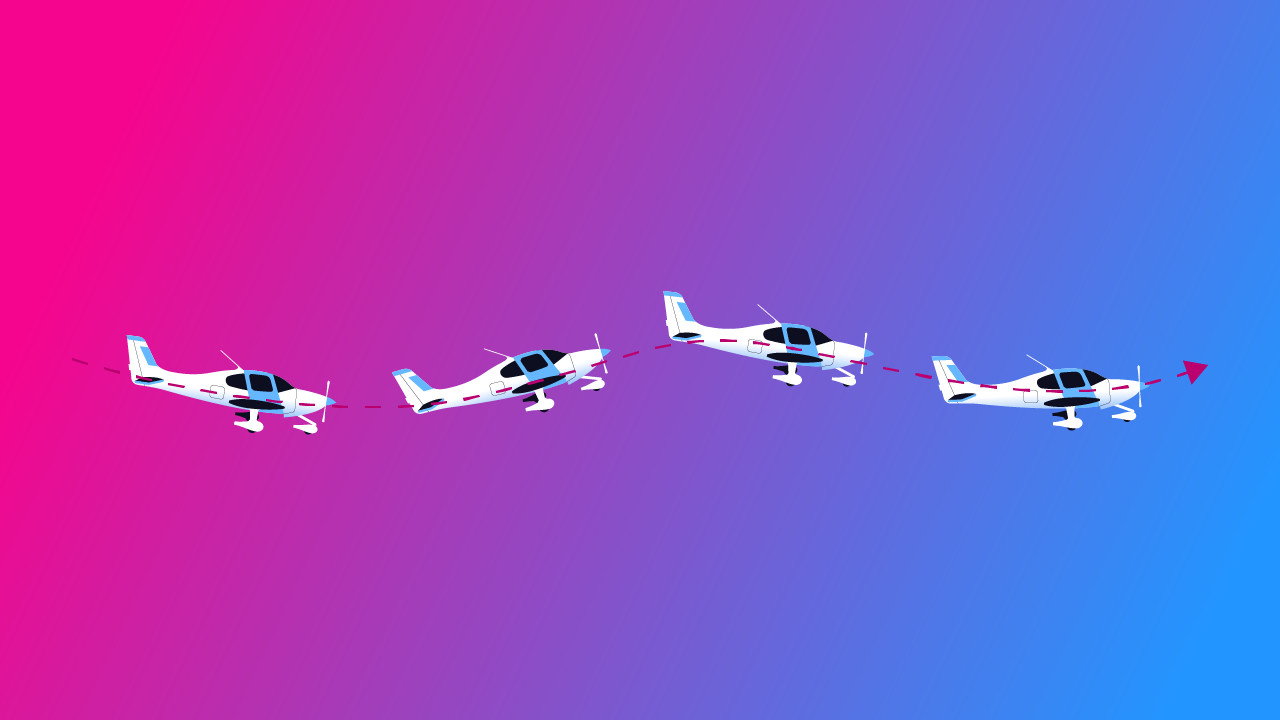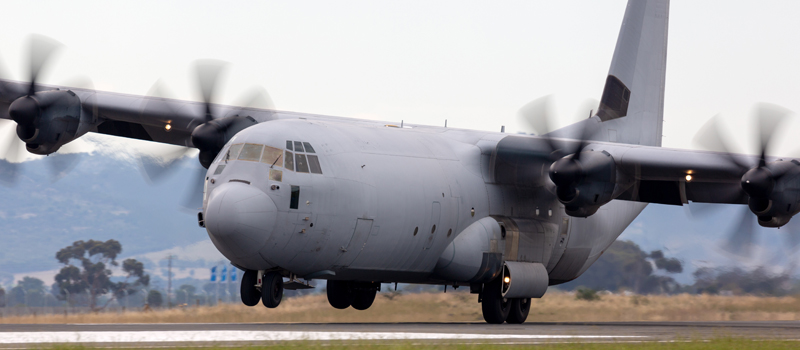-
Key Takeaways:
-
Understanding Phugoid Motion
- What Is Phugoid Motion?
- The Physics Behind Phugoid Oscillations
- What Happens in Phugoid Motion?
-
Causes and Triggers of Phugoid Motion
-
Phugoid Motion and Aircraft Stability
-
Recognizing Phugoid Motion in Flight
-
Managing and Controlling Phugoid Motion
- Piloting Techniques
- Using the Autopilot
-
Real-World Examples and Case Studies
- Notable Incidents Involving Phugoid Motion
- Lessons Learned from Incidents
-
The Role of Flight Dynamics and Design
- Weight Distribution Effects
- Aerodynamic Effects
- Stability Control Systems
-
Importance of Understanding Phugoid Motion
-
Conclusion
What happens if you let go of the controls while flying the aircraft? It may sometimes gently bob up and down in a smooth, rhythmic pattern as it flies. What can make an aircraft do that?
This is a phenomenon called phugoid motion.
While it sounds exotic, it’s actually a very simple concept.
We’ll discuss how phugoid motion relates to your aircraft’s stability, what you can do to counter it, and even look at what it can do to an aircraft in severe cases.
Key Takeaways:
- Phugoid motion is a slow, long‑period exchange between airspeed and altitude. The aircraft’s angle of attack stays relatively constant.
- It is triggered by a disturbance, such as gusts, abrupt control inputs, or power changes.
- Pilots can let the aircraft’s natural damping resolve the issue or make small, well-timed inputs.
- In extreme loss-of-control cases, an uncontrolled phugoid motion can become deadly.
Understanding Phugoid Motion
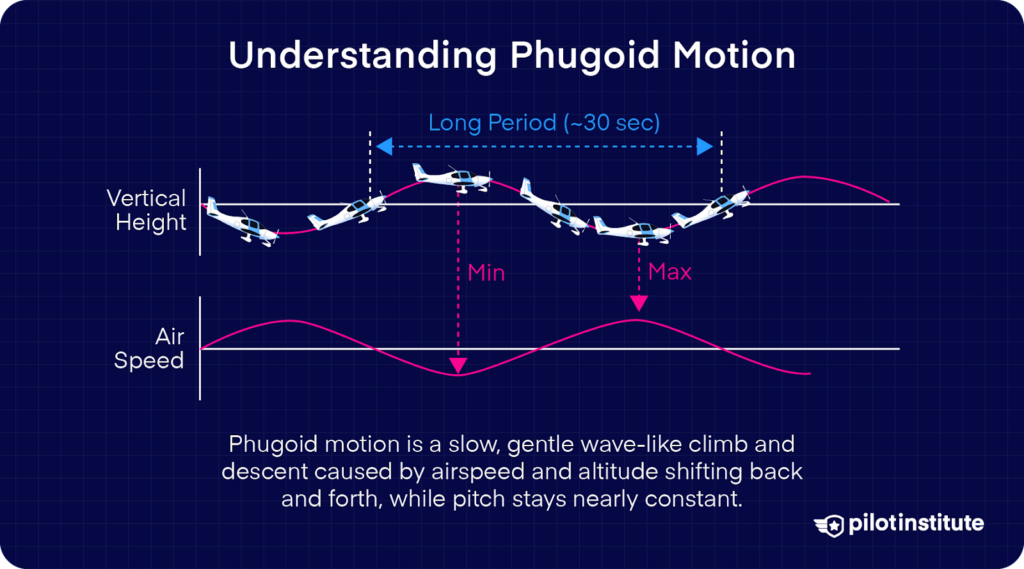
What Is Phugoid Motion?
In simple terms, a phugoid is a long and gentle oscillation in an aircraft’s pitch and altitude. The nose swings up and down slowly, causing the aircraft to climb and descend in a repeating cycle.
If you’re visualizing tossing and turning, such as caused by turbulence, stop. That’s completely different. Phugoid motion is very gradual. In fact, passengers are very likely not to notice it at all.
This type of motion is a long-period oscillation since each swing takes a long time.
The Physics Behind Phugoid Oscillations
In every oscillation, whenever a body moves to one extreme position, it gains potential energy. This potential energy converts to kinetic energy as the body returns to the mean position.
The kinetic energy is converted back to potential energy on the other side of the oscillation until the body reaches the other extreme.
If you’re picturing a pendulum, you’ve got the right idea.
How does this relate to phugoid motion in an aircraft, though?
In aircraft, this motion involves climbing and descending in a repeating cycle. The aircraft experiences a slow change in pitch angle, whereas airspeed varies noticeably.
Just like pendulums only begin their oscillation after being pulled to one extreme, phugoid motion is generally triggered by some external disturbance. This could be a wind gust or a pilot making a control input.
What Happens in Phugoid Motion?
The aircraft’s Angle of Attack (AoA) stays roughly constant throughout the cycle.
Why is that important?
The AoA is the angle between the wing and the oncoming airflow. This means pitching‑moment changes are small, but lift still rises and falls with airspeed. The oscillation is just an exchange between airspeed and altitude.
As the aircraft climbs, its airspeed decays. As it descends, it regains speed. This constant exchange creates the oscillation.
That’s why, for a passenger, phugoid motion feels like a series of slow climbs and descents instead of pitching up and down. That is, of course, if they feel it at all.
Aircraft such as small Cessnas may complete a cycle in around half a minute. Airliners may take a couple of minutes for a single oscillation.
The exact period depends on the aircraft’s speed and design, but generally, bigger, faster, and more efficient aircraft have longer, slower phugoid cycles.
The motions are gentle enough that pilots sometimes correct them by making small control or power adjustments without even realizing it’s happening.
Causes and Triggers of Phugoid Motion

Phugoid motion doesn’t usually start on its own. It’s typically triggered by some disturbance in the aircraft’s balance. Here’s what that could look like:
- Control inputs: Abrupt changes in pitch by harshly pulling or pushing the control yoke can induce a phugoid.
- Power changes: Adding power naturally raises the nose in many aircraft. Reducing power drops the nose. If the effect isn’t corrected, the aircraft can enter a phugoid.
- Turbulence or gusts: Bumps from wind gusts or turbulence give an initial disturbance in pitch that induces phugoid.
In all cases, the disturbance knocks out the aircraft’s balance. If not corrected, the aircraft keeps “hunting” for the trimmed speed and altitude, creating the cyclic motion that characterizes phugoid movement.
Phugoid Motion and Aircraft Stability
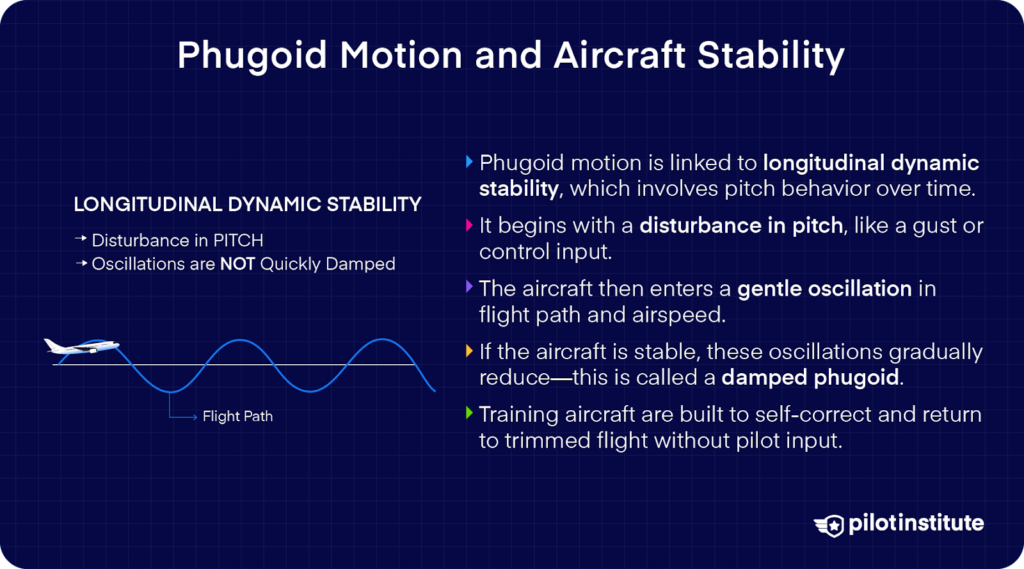
Phugoid motion is closely related to an aircraft property called longitudinal stability.
Longitudinal stability is an aircraft’s stability in the pitch axis. Basically, a longitudinally stable aircraft will naturally return to its trimmed condition after its pitch is disturbed.
This is why we trim the aircraft in the first place. A properly trimmed aircraft maintains steady flight with minimal pilot input.
If a gust of wind or some other factor upsets the aircraft, a stable design will start nudging it back toward the original attitude and airspeed.
The phugoid oscillation is actually a sign of longitudinal stability doing its job. When your aircraft’s nose gets nudged up or down, stability doesn’t usually smack it right back to level immediately.
The aircraft gradually swings around the trimmed position, each swing being a little smaller than the last, until it levels off at the trimmed position.
This is called a damped or convergent phugoid. Aircraft manufacturers design training and general aviation aircraft to react this way when disturbed in pitch. If you lose focus while flying the aircraft and let it wander up and down, its design is supposed to correct it.
Recognizing Phugoid Motion in Flight
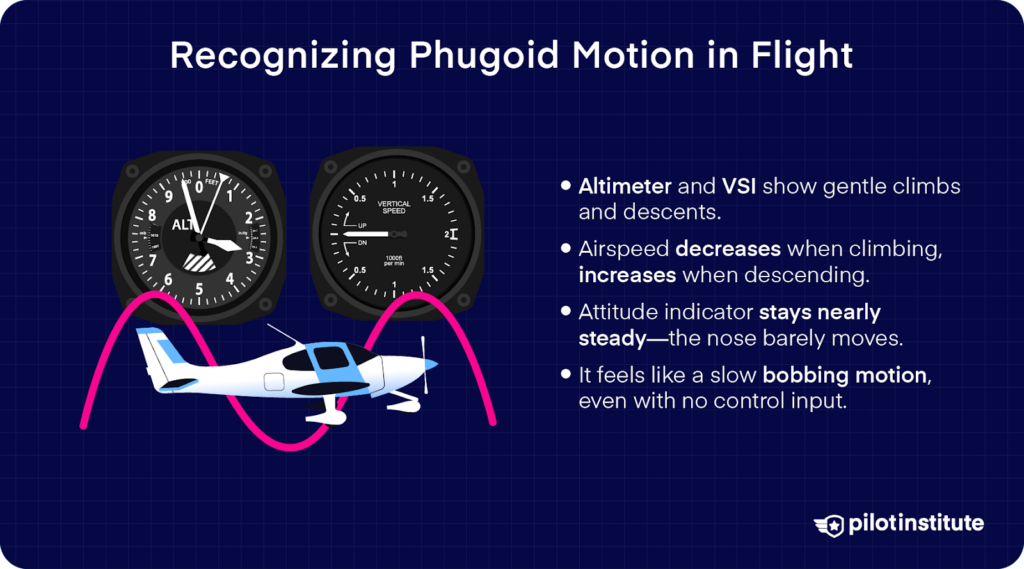
How would you know you’re caught in a phugoid cycle?
Since it’s generally too gentle to be noticeable, your instruments will most likely give you your first indications of an existing phugoid cycle.
- Notice the altimeter needle swing up and down gently, up to a few hundred feet.
- The Vertical Speed Indicator (VSI) will show a cycle of shallow climbs and descents.
- Meanwhile, the Airspeed Indicator moves the opposite way: decreasing during the climbs and increasing during descents.
Notice that the attitude indicator hardly moves at all. The aircraft doesn’t dramatically pitch up or down, and the yoke isn’t being moved. Despite that, the aircraft is slowly bobbing through the air.
To the pilot, it might feel like the aircraft is subtly floating upward, then settling downward, over and over. If you pay attention to the nose, you may notice it moving slightly against the horizon over time.
Managing and Controlling Phugoid Motion
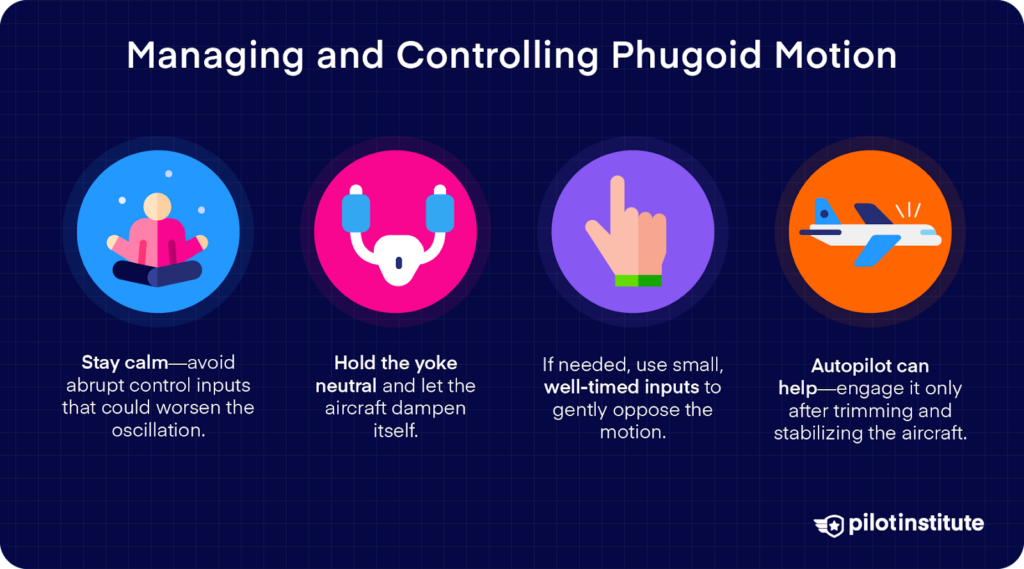
Piloting Techniques
Now that you know what to look for, how do you manage an aircraft caught in phugoid oscillations?
Well, firstly, resist the urge to move the flight controls around abruptly. There’s a good chance of overcontrolling the aircraft if you panic. If you time your inputs wrong, you can accidentally make the oscillations more severe.
In most cases, the best thing to do would be just to keep the yoke in the neutral position. Let the aircraft’s design dampen the oscillations on its own.
If the oscillations don’t seem to dampen out, or you’re drifting away from your assigned altitude too much, you can intervene gently.
Apply small inputs at the right time to oppose the motion. For example, give a slight forward pressure to check the climb as the nose passes the horizon while moving upward.
You’re essentially interrupting the oscillation at its midpoint rather than the extremes. Return the yoke to neutral and see what happens. You generally won’t need more than one or two well-timed inputs to break the cycle.
Using the Autopilot
Does your aircraft have an autopilot? Autopilots are great at handling phugoid motions since they can react faster and more precisely.
Even a basic pitch‑hold or altitude‑hold autopilot can handle a phugoid oscillation very well. You can simply engage the autopilot to let it make the fine corrections at the right time.
Make sure the aircraft is trimmed and roughly stable before handing over control to the autopilot. You don’t want the autopilot to command a sudden pitch change as you engage it. That could just end up with the autopilot “chasing” the phugoid.
If the autopilot doesn’t handle the situation, take over manually and re-trim the aircraft. Once it stabilizes, you can try engaging the autopilot again.
Real-World Examples and Case Studies
Notable Incidents Involving Phugoid Motion
Phugoid motion is not a dangerous phenomenon in itself. However, it has been involved in aircraft accidents where the pilots experienced a loss of control. Once pilots lose control, the aircraft is left to the mercy of phugoid oscillations.
In 1985, Japan Airlines Flight 123’s tail section blew out from explosive decompression, cutting all the aircraft’s hydraulic lines. This disabled all flight controls, leaving the crew to maneuver the aircraft with engine thrust only.
The Boeing 747 flew into a phugoid oscillation for 32 minutes with the crew desperately trying to navigate the aircraft to safety. Tragically, the aircraft crashed in what became the deadliest single-aircraft accident in aviation history.
It is possible for pilots to maneuver the aircraft to an airport if they manage to keep severe phugoid oscillations in check. In 1989, United Airlines Flight 232 lost all hydraulics after an uncontained engine failure.
The pilots used differential thrust to navigate to Sioux City airport. Unfortunately, the DC-10 broke apart on landing. 184 people out of 296 survived the crash, showing that the pilots’ efforts did make a difference.
Lessons Learned from Incidents
These incidents can teach us how to manage severe phugoid motion in aircraft.
In normal flying, you’d never encounter this type of extreme phugoid because you have control inputs available and your aircraft is intact.
However, if things go wrong, it’s clear that severe phugoid oscillations can be catastrophic if not controlled.
Lessons learned from how the United Airlines pilots used their engines to manage the phugoid made their way into pilot training.
In 2003, a DHL A300 also lost its hydraulic systems, but the pilots used their understanding of phugoid oscillations and energy management to deal with the situation. They managed to bring the aircraft safely to a runway on engine control alone with zero fatalities.
The Role of Flight Dynamics and Design

Every aircraft model handles phugoid motion differently. Engineers can adjust factors like aircraft weight distribution, aerodynamics, and control systems to change how it experiences phugoid motion.
Weight Distribution Effects
For example, moving the aircraft’s Center of Gravity (CG) aft makes it less stable in pitch. It may experience barely damped, neutral, or even unstable phugoid motion.
This means it’ll be harder for the aircraft to eliminate oscillations if you let go of the yoke. An unstable phugoid motion means the oscillations will get worse over time.
Conversely, it’s also possible to set the CG too far forward. In this case, the aircraft will be so nose-heavy that it’ll be hard to flare and mushy to maneuver.
Aerodynamic Effects
Another factor is the relationship between the aircraft’s wing and horizontal tail.
It’s possible to design a tail that’s set at an angle or size that aggressively forces the nose back to level after a disturbance. While you might think that’s a good thing, it can actually lead to an overcorrection and start an oscillation.
In fact, an unstable or divergent phugoid can result from a large difference between the wing’s incidence (angle at which it’s mounted) and the tail’s incidence.
A more mildly tuned stability setup has a slightly smaller tail or a tail located further aft on a longer fuselage. This usually produces a gentler, well-damped phugoid.
Stability Control Systems
Many modern jets are intentionally designed to have lower inherent stability to achieve better maneuverability or efficiency.
Engineers use computer control laws to manage the aircraft and artificially make them act stably.
For example, a fly-by-wire airliner might automatically add a bit of pitch input if it senses a long-term oscillation developing.
The computer does this automatically, with the pilot not even being aware of these small adjustments. This lets the aircraft be both agile and stable from the pilot’s perspective.
Importance of Understanding Phugoid Motion
As a pilot, why do you need to know about phugoid motion?
Understanding phugoid motion tells you how the aircraft will behave if left alone. It tells you what the aircraft wants to do.
If you do encounter a phugoid cycle, you may need to act against your instincts by leaving the controls alone. That’s very counterintuitive for any pilot. It’s also what saves you from getting into a pilot-induced oscillation.
Flight instructors often demonstrate a phugoid to student pilots as a lesson in an aircraft’s natural stability.
For example, your instructor might have you trim the aircraft for level flight at a certain airspeed. Then they may disturb the aircraft’s pitch (say, with a brief pull on the yoke) and have you watch what happens. This teaches you speed stability, and the importance of trimming the aircraft.
Pilots who understand phugoid motion are also more careful about trimming their aircraft since they know an out-of-trim aircraft is basically a phugoid waiting to happen.
Conclusion
Good airmanship is often defined by anticipation and finesse. Knowing about phugoid motion gives you a bit of both.
It teaches you to develop a more refined touch on the controls, intervening only when necessary, and in the correct manner.
Your flying will become smoother as a result, which is something your passengers will appreciate, too!
